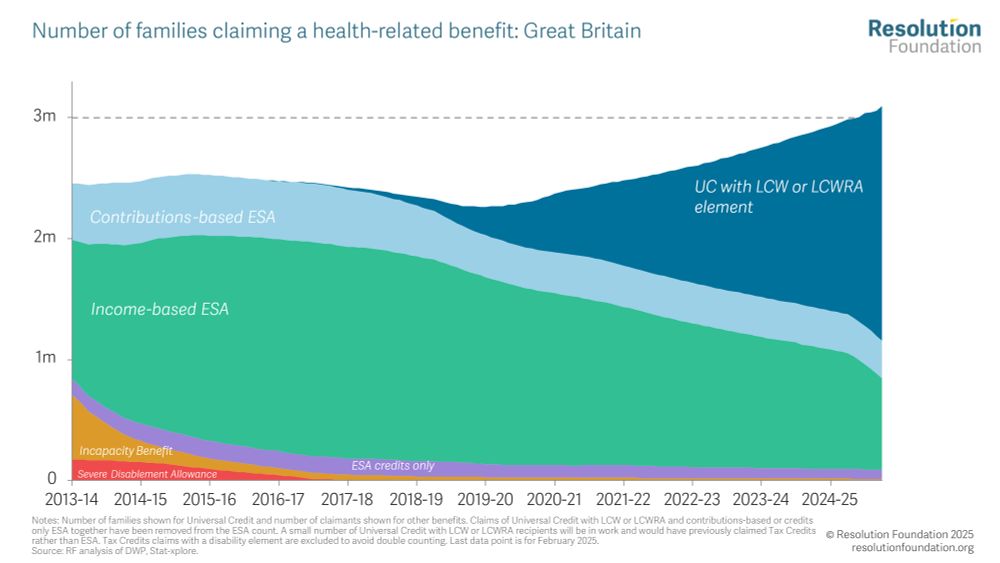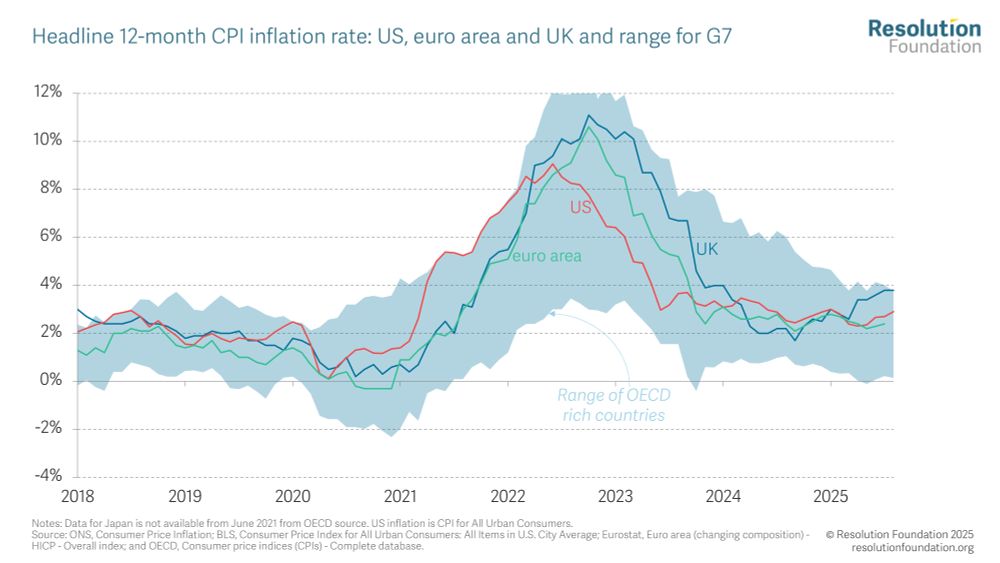
Louise Murphy
@louisemurphy.bsky.social
Senior Economist at the Resolution Foundation, focusing on employment, young people and health | views my own
Finally, it's important to think about what this weakening pay growth means for workers.
Average weekly pay has increased by just £3 in real terms over the past year – not even enough to cover the cost of a Tesco meal deal.
Average weekly pay has increased by just £3 in real terms over the past year – not even enough to cover the cost of a Tesco meal deal.

November 11, 2025 at 9:07 AM
Finally, it's important to think about what this weakening pay growth means for workers.
Average weekly pay has increased by just £3 in real terms over the past year – not even enough to cover the cost of a Tesco meal deal.
Average weekly pay has increased by just £3 in real terms over the past year – not even enough to cover the cost of a Tesco meal deal.
Pay growth has been fastest in low-paying sectors, with April’s minimum wage increase playing an important role.
Since January 2025, nominal wages in wholesale, retail and hospitality have grown at four-times the rate (5.6 per cent) of wages in finance and business (1.3 per cent).
Since January 2025, nominal wages in wholesale, retail and hospitality have grown at four-times the rate (5.6 per cent) of wages in finance and business (1.3 per cent).

November 11, 2025 at 9:07 AM
Pay growth has been fastest in low-paying sectors, with April’s minimum wage increase playing an important role.
Since January 2025, nominal wages in wholesale, retail and hospitality have grown at four-times the rate (5.6 per cent) of wages in finance and business (1.3 per cent).
Since January 2025, nominal wages in wholesale, retail and hospitality have grown at four-times the rate (5.6 per cent) of wages in finance and business (1.3 per cent).
Across the whole economy, regular earnings grew by 4.6 per cent over the year to September.
After we account for inflation, wages are still growing, albeit very slowly (at just 0.5 per cent over the past year).
After we account for inflation, wages are still growing, albeit very slowly (at just 0.5 per cent over the past year).

November 11, 2025 at 9:07 AM
Across the whole economy, regular earnings grew by 4.6 per cent over the year to September.
After we account for inflation, wages are still growing, albeit very slowly (at just 0.5 per cent over the past year).
After we account for inflation, wages are still growing, albeit very slowly (at just 0.5 per cent over the past year).
This weakening labour market is also showing up in pay.
Short-term measures of pay growth suggest a rapid slowdown in recent months: the annualised three-month change in private sector pay fell to just 2.7 per cent in September.
Short-term measures of pay growth suggest a rapid slowdown in recent months: the annualised three-month change in private sector pay fell to just 2.7 per cent in September.

November 11, 2025 at 9:07 AM
This weakening labour market is also showing up in pay.
Short-term measures of pay growth suggest a rapid slowdown in recent months: the annualised three-month change in private sector pay fell to just 2.7 per cent in September.
Short-term measures of pay growth suggest a rapid slowdown in recent months: the annualised three-month change in private sector pay fell to just 2.7 per cent in September.
But the big news today is that unemployment has risen to 5 per cent for the first time since 2016 (outside of the pandemic period). This has happened more quickly than expected.
Worryingly, we’re almost at peak pandemic levels of unemployment – unemployment peaked at just 5.3 per cent in 2020.
Worryingly, we’re almost at peak pandemic levels of unemployment – unemployment peaked at just 5.3 per cent in 2020.

November 11, 2025 at 9:07 AM
But the big news today is that unemployment has risen to 5 per cent for the first time since 2016 (outside of the pandemic period). This has happened more quickly than expected.
Worryingly, we’re almost at peak pandemic levels of unemployment – unemployment peaked at just 5.3 per cent in 2020.
Worryingly, we’re almost at peak pandemic levels of unemployment – unemployment peaked at just 5.3 per cent in 2020.
As a result, our Resolution Foundation employment estimate (which combines payroll employment data with population estimates) has fallen to 75.1 per cent – well below the peak employment rate of 76.6 per cent in mid-2023.

November 11, 2025 at 9:07 AM
As a result, our Resolution Foundation employment estimate (which combines payroll employment data with population estimates) has fallen to 75.1 per cent – well below the peak employment rate of 76.6 per cent in mid-2023.
The number of payrolled employees fell by 32,000 in both September and October, meaning that payrolled employment is down by 180,000 since its peak in October last year.

November 11, 2025 at 9:07 AM
The number of payrolled employees fell by 32,000 in both September and October, meaning that payrolled employment is down by 180,000 since its peak in October last year.
..and join our event this morning at 9.30am, with Richard Rigby from The King's Trust and Barry Fletcher from Youth Futures Foundation, to hear about the findings of the report.
www.resolutionfoundation.org/events/seeki...
www.resolutionfoundation.org/events/seeki...

Seeking a NEET solution • Resolution Foundation
height="100%" width="100%" frameBorder="0" style="min-height: 560px;" allow="clipboard-write" title="Slido"> The number of 16-24 year olds who are not in employment, education or training (NEET) is in...
www.resolutionfoundation.org
October 21, 2025 at 7:55 AM
..and join our event this morning at 9.30am, with Richard Rigby from The King's Trust and Barry Fletcher from Youth Futures Foundation, to hear about the findings of the report.
www.resolutionfoundation.org/events/seeki...
www.resolutionfoundation.org/events/seeki...
Of course, researchers try to make sense of this by collating lots of different DWP data releases...
But we shouldn't expect journalists to do this every month. Until DWP publish their data more clearly, we shouldn't be surprised if misleading and unforgiving headlines keep coming.
But we shouldn't expect journalists to do this every month. Until DWP publish their data more clearly, we shouldn't be surprised if misleading and unforgiving headlines keep coming.

October 7, 2025 at 8:13 AM
Of course, researchers try to make sense of this by collating lots of different DWP data releases...
But we shouldn't expect journalists to do this every month. Until DWP publish their data more clearly, we shouldn't be surprised if misleading and unforgiving headlines keep coming.
But we shouldn't expect journalists to do this every month. Until DWP publish their data more clearly, we shouldn't be surprised if misleading and unforgiving headlines keep coming.
What makes this more frustrating is that DWP knows this is an issue and has the data it needs to publish clearer stats. It published a whole article on the various factors contributing to the rise in health-related benefit claims back in January: www.gov.uk/government/s...

Decomposition of growth in the number of claimants of Universal Credit with Limited Capability for Work and Work-Related Activity, or in the Employment and Support Allowance Support Group
www.gov.uk
October 7, 2025 at 8:13 AM
What makes this more frustrating is that DWP knows this is an issue and has the data it needs to publish clearer stats. It published a whole article on the various factors contributing to the rise in health-related benefit claims back in January: www.gov.uk/government/s...
...Again, this isn't inevitable. DWP could publish, as standard, time-series charts of people claiming UC or equivalent legacy benefits. UC has been rolling out for over a decade now - it's not like this has come as a surprise!
October 7, 2025 at 8:13 AM
...Again, this isn't inevitable. DWP could publish, as standard, time-series charts of people claiming UC or equivalent legacy benefits. UC has been rolling out for over a decade now - it's not like this has come as a surprise!
Case study 2: UC stats get written up as 'rise in claimants not required to work' - and anyone glancing at this chart would think there's been an extraordinary change in benefit claims. You have to read footnotes/surrounding text to know that there's been a corresponding fall in ESA claims...

October 7, 2025 at 8:13 AM
Case study 2: UC stats get written up as 'rise in claimants not required to work' - and anyone glancing at this chart would think there's been an extraordinary change in benefit claims. You have to read footnotes/surrounding text to know that there's been a corresponding fall in ESA claims...
...Yet it's impossible to know how much of this relates to people moving from one part of the benefits system to another or a genuine rise in people making new claims for sickness benefits. Surely it's in DWP's interest to prioritise publishing WCA data for new claimants vs those migrating from ESA?
October 7, 2025 at 8:13 AM
...Yet it's impossible to know how much of this relates to people moving from one part of the benefits system to another or a genuine rise in people making new claims for sickness benefits. Surely it's in DWP's interest to prioritise publishing WCA data for new claimants vs those migrating from ESA?
Case study 1: DWP count people who go through a Work Capability Assessment when they move from ESA to UC as a 'new' claimant. So when you draw a time-series chart of Work Capability Assessments - even if you limit it to 'initial' assessments - you see a big spike in recent months...


October 7, 2025 at 8:13 AM
Case study 1: DWP count people who go through a Work Capability Assessment when they move from ESA to UC as a 'new' claimant. So when you draw a time-series chart of Work Capability Assessments - even if you limit it to 'initial' assessments - you see a big spike in recent months...
Reposted by Louise Murphy
Inflation holding steady at 3.8% leaves the UK with the highest headline CPI inflation in the G7 and the joint highest (with Iceland, also 3.8% in Aug) among OECD rich countries. A chunk of this is policy related (NI rise, higher administered prices, eg water bills, and food packaging regulation).

September 17, 2025 at 7:40 AM
Inflation holding steady at 3.8% leaves the UK with the highest headline CPI inflation in the G7 and the joint highest (with Iceland, also 3.8% in Aug) among OECD rich countries. A chunk of this is policy related (NI rise, higher administered prices, eg water bills, and food packaging regulation).

